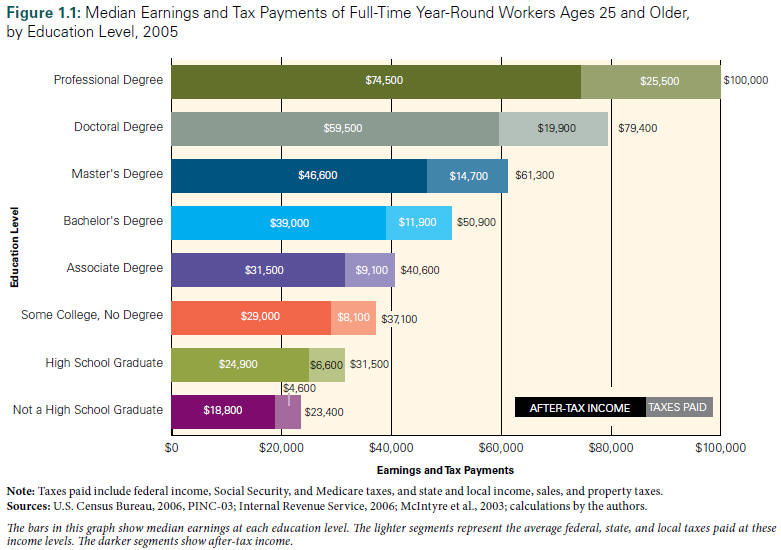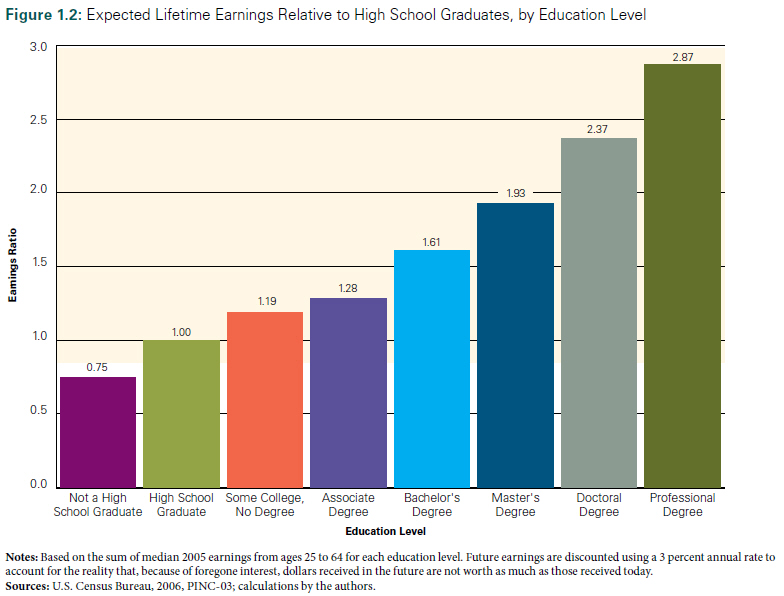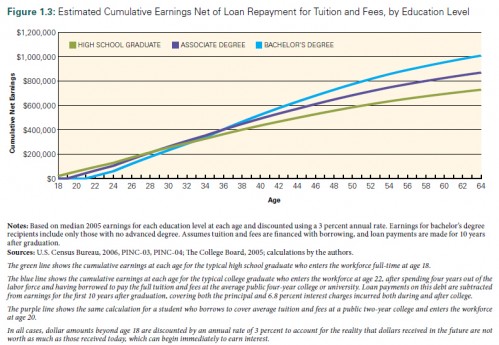Update: Coincidentally, Anya Kamenetz just posted an interview in which she briefly compares the student loan situation with the real estate bubble here.
When I opened my email the other day, I was greeted by the following blurb from Today’s Campus:
The U.S. college-buying public numbers in the tens of millions. Many of them are first-time purchasers. Most of them are not. Among a marketplace of that size, one ‘buying cluster’ could supply enough students to fill several campuses. One very interesting cluster we’ve identified is husbands purchasing higher education for their wives. Click here to order a free sample report with our compliments.
We don’t often hear higher education talked about in such baldly commercial terms. Most faculty and campus administrators have visceral negative reactions to this kind of language. But that doesn’t mean that colleges—even not-for-profit colleges—aren’t essentially run as businesses. It just means that (a) they’re often run as businesses badly because it is considered distasteful to draw on the lessons and vocabulary of the business world, and (b) educators often fail to identify the tensions between their school’s mission and its operating model, thus making it less likely that they will be able to confront some of the system’s ethical challenges successfully. But since the heart of DIY U is an economic argument, it is worthwhile to try framing issues in the language of economics. As the title of this post suggests, the specific question I want to address is whether there is a bubble in the college education market.
An economic bubble is what happens when the price of an asset class rises dramatically and well out of proportion with the rise in its intrinsic value. So the first question you ask when looking for a bubble is whether there has been an outrageous price spike. Has there been an alarming spike in the price of a college degree?
Here’s a graph of the cost of a four-year degree at Rensselaer Polytechnic Institute (RPI) from 1950 to 2009:

Yikes. I would certainly call that alarming. But maybe RPI is an anomaly. A College Board report I found has a chart of the changes in cost of degrees at four-year colleges from 1976-77 to 2006-07. Let’s see what that looks like in the form of a graph:

If anything that looks even worse.
But is that rise out of proportion with the intrinsic value of a college education? That’s a harder question to answer. According to a 2007 study by the College Board, an undergraduate degree makes a pretty substantial difference in annual income:

College looks like a good deal in this graph. Here’s a graph of expected lifetime earnings from the same report:

Again, it looks pretty good so far.
But wait. What if we factor in college debt? Here’s what happens:

What you want to look at here is where the purple and blue lines (representing the net income after college debt of people with two-year and four-year degrees, respectively) cross the green line (representing the baseline income of people with high school educations). It turns out that the average Associates Degree—if you go to school immediately upon high school graduation and earn it in two years, which are both dubious assumptions—will start paying off net of debt (on average) when you turn 29, or after nine years of full-time work. If you get a four-year bachelor’s degree—again, assuming that you go right to college after high school and complete it in four years—it will take you on average until you are 34 years old, or 14 years of full-time work after graduation.
In assessing the degree to which there may be a gap between the cost of a college degree and its value, a lot depends on what you assume about the people doing the evaluation. If we were all strictly rational long-term-income-maximizing automata, a college degree would still look like a good deal on average. After all, you make substantially more by the end of your life. Let’s call this the efficient market theory of college pricing. But as we have recently discovered much to our pain, markets aren’t always efficient. A more reasonable theory might be that most college students and their parents simply don’t do this calculation. They take it on faith, with perhaps a sprinkling of anecdote and experience of generations past, that having a college degree is worth the investment prima facie. This evaluation would be helped, of course, by the fact that there can be very good reasons to go to college other than pure economic pay-back. But at the very least, I suspect that the number of people who would be willing to get a degree knowing that it may not pay off for quite some time would be significantly smaller than the number of people who are getting their degrees right now.
The other thing to consider here is that we’re talking about averages. As my father likes to say, if you stick your head in the oven and your feet in the freezer, on average you’ll be comfortable. I’d like to see what the payback period is for students going to the bottom two quintiles of colleges. How big is the payback gap between a Harvard graduate and a Whatsamatta U graduate? My guess is that it’s big enough to change the look of these graphs entirely. For a significant number of graduates from the bottom quintile of schools—especially those that started late and/or had to go to school part time while working—it’s possible that the degree may never pay for itself. Again, this is just a guess, but I would like to see that data.
This situation is likely to get worse rather than better. College costs continue to rise dramatically while wages stagnate. Take a look a this graph of education-based differences in income from 1971 to 2005:

Look at the graph for males, on the right side. Income for college graduates actually declined in real dollars from 1971 to 2005. The reason main reason why a college education “pays” is because income for non-college-educated males declined a lot more. Unless either real wages go up or college costs stop climbing through the roof, the College Board may soon have to publish a report entitled “College Doesn’t Pay.”
So here’s what we know:
- The cost of a college education has climbed at a rate that raises the question of whether there is an economic bubble.
- The cost of education, on average, is lower than its lifetime payback, but the gap is probably a lot less than many students and parents realize.
- It is entirely possible that, for some significant portion of the college-going population, costs have already exceeded pay-back.
- Costs continue to rise rapidly while payback is falling in absolute real dollar terms and is mainly considered payback at all because the income of the non-college-educated is falling in absolute real dollar terms at an even faster rate.
It sure feels like it could be a bubble. Let’s add the fact that these tuition rises are financed primarily through credit. Larger and larger portions of student education are financed on debt as easy credit feeds an arms race among colleges where one of the two primary markers of “quality” in the market is cost. I’m not going to lay out the details here; if you need to be convinced, then read chapter 3 of DIY U. Kamenetz does a much better job of making the case than I could in the space of a blog post. Suffice it to say that we have too much money chasing after too few assets, which is a classic cause of economic bubbles.
I believe thinking about the college situation in terms of an economic bubble can be useful because it gives us a model to think through implications such as the following:
- Bubbles burst. Always. If what we are experiencing is a bubble in the higher education market, then we can expect a dramatic collapse in the price of a degree at some point.
- The two most likely triggers of the bubble bursting would be either credit drying up or demand dropping off—and these tend to go together. Credit could dry up if the number of students defaulting on loans increases, which is inevitable if the cost of education relative to real incomes continues to rise as it has. Demand could drop off if a significant number of prospective students discover lower-cost paths to the same economic track, i.e., if significant numbers of students as rational investors in their own futures find alternative investments that have better cost/benefit ratios than college and the debt that it brings with it. This is exactly what Kamenetz is calling for.
- If there is a bubble and it bursts, it wouldn’t necessarily mean the end of higher education as we know it, but it would probably mean large and painful contractions in college budgets leading to layoffs, cuts in services and the closing of a significant number of colleges.
- Students in the “sub-prime” position who are taking on large amounts of high-interest debt to get educations from low-performing schools are likely to be hurt worst as those schools crumple under the hardships caused by the bubble bursting. And, unlike your home, your education is a fundamentally illiquid asset. You can’t sell off your diploma, even at a loss, to pay back your bank loans. These students will be screwed six ways from Sunday, which is even more ways than they’re getting screwed now.
Scary.
Wow, this is an epic post, and you play-by-play through the graphs and stats is impressive. So much better to have the collapse narrated rather than just taken prima facie 🙂
The problem I have with charts like the third one (median income based on education attained) is that we are comparing high achievers (those going on to college, generally) with lower achievers (those not attending college, generally – certainly room for argument there). There should be a gap between these different populations whether or not they ever went to college.
Stated differently, what would the professional degree person have earned if s/he never went to college, but became an entrepreneur or otherwise climbed the ladder as a high-achieving, super-smart person without the degree? Obviously, that’s hard to know, but I question whether a big part of this has more to do with the person and less to do with the formal education. Clearly, I have no data to stand on here.
Great analysis. I agree with your premise and summary conclusions. Now, how the bridge forms between “need” ( students need a different kind of educational content/tools that will give them more personalized knowledge and a better ROI), and “product” (open resources etc.) is still the part we can’t map precisely but can make guesses about. I think it would be naive to think that some major and profound alternative will not take market share form existing Higher Ed options.
I agree, Barry, and your point simply reinforces mine (and Kamenetz’s). If these people would have succeeded whether or not they went to college, then the value of that education is correspondingly less.
Thanks for posting these numbers and this analysis. I’m with Barry on the comment that the value of education is relative to the individual. To some, it’s an education that makes them a higher-functioning individual; to others, its a hoop-jumping exercise that is necessary for credential or respect or access to positions. I find that’s especially true amongst those who are professionally employed but are compelled–either internally or externally–to return to college for a higher degree. At my institution, for instance, the change from state college to university required that a large number of faculty go back to school for terminal degrees. I daresay that the benefit of advanced degrees for these people is far less dramatic than it may be for someone younger or less experienced.
Which, I guess, is a long-winded way of saying stats apply to populations, not individuals! It would be nice to better understand how college may benefit different individuals more than saying, “You’ll make more money.”
Great post Michael. I think the other thing worth mentioning is the continuing push from national governments to expand participation in HE (or at least, the number of people with degrees). Targets of 50% are not uncommon. You might expect the relative long term advantages of those with first degrees to decline in future. If the current costs of undergraduate education remain the same there will be an increasing amount of personal debt that will become unserviceable.
Hey, great post and many of these charts and graphs are in the presentation that I give to college audiences.
When thinking about the value of the degree you have to also take into account the very large group of college non-completers–44% says the Dept. of Ed. They have some student loan debt, and incomes that are higher than high school grads on average but lower than college grads.
Anya, do you know anybody who has finer grained stats? Cross-tabs broken out by economic class, for example?
It’s an accepted framing device among historians of higher education to describe the university as an institution that has historically functioned as a gateway to the middle class. But if that used to be the case what about now? Perhaps, as you seem to be saying, not so much. Still, how one defines entry into the middle class isn’t strictly measured via earnings and salary (or whether one can afford the fees of the local country club). It also depends on whether one shares the same social referents and language of the class one is trying to gain entry into. In Thorstein Veblen’s day (one of the first educational critics to speak of the university in these terms) it meant learning Latin. In today’s educational landscape the social markers are a bit looser and harder to identify yet they are still there (even Anya is made to make passing mention of her Yale education in her Salon interview, and I bet she’s at least as proud – as she rightly should be — of her ideas and her self-proclaimed ‘book-worminess’ as she is of whatever tax bracket it’s propelling her into). In short maybe there’s an educational bubble. But a broader narrative that extends beyond earnings and salary measures is needed to describe it.